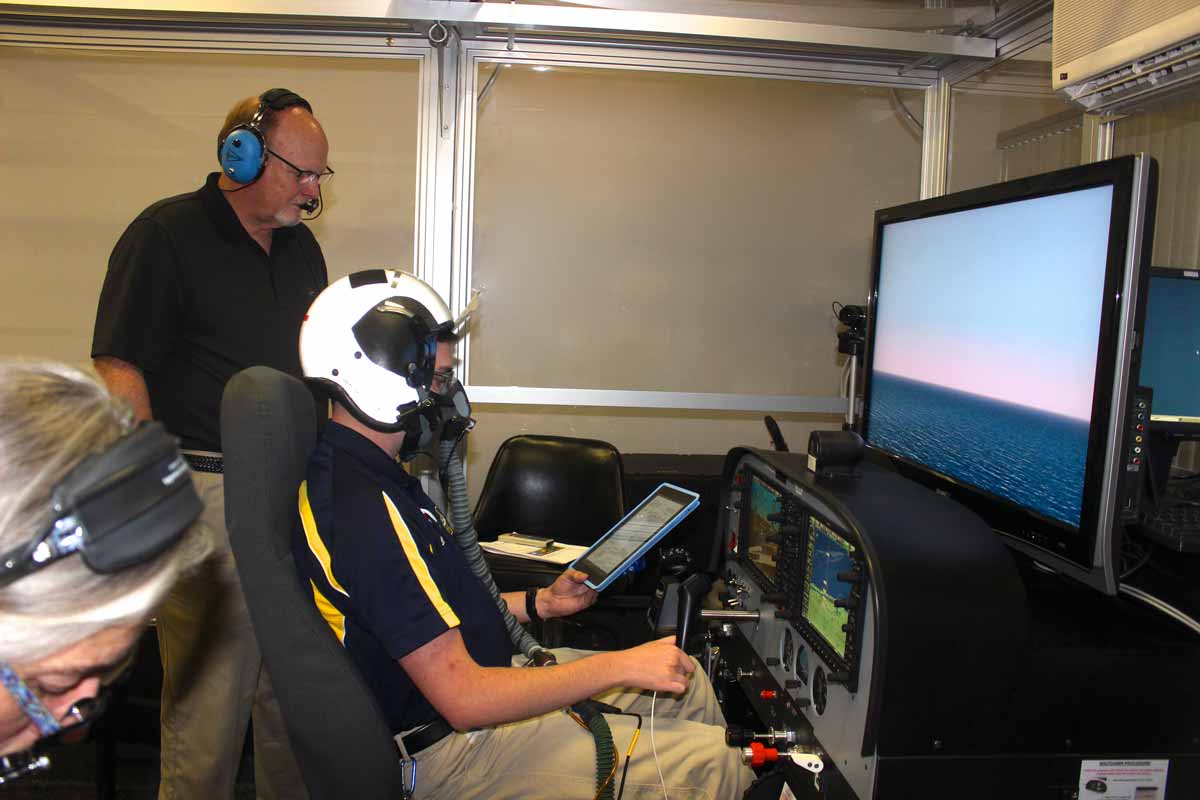Aviation Safety: Efforts to Combat Hypoxia Win Top Honor

Helping pilots swiftly recognize and respond to the first signs of deadly oxygen deficiency, or hypoxia, is the focus of two Embry-Riddle research projects that contributed to a U.S. Navy project that won a 2018 Innovation Award from the Naval Air Warfare Center Aircraft Division (NAWCTSD).
Separate projects led by Assistant Professor of Aeronautical Science Janet K. Marnane and Associate Professor of Human Factors Joseph R. Keebler are designed to better understand, prevent and even predict hypoxia among pilots in flight. The projects are part of the university’s programs in Aeronautical Science as well as Human Factors, on the Daytona Beach Campus.
The Navy’s Hypoxia Training Research and Development projects, supported by Embry Riddle, are setting the stage for “innovative training solutions to better equip the fleet in dealing with aeromedical issues,” said Beth F. Wheeler Atkinson, senior research psychologist with the Naval Air Warfare Center Training Systems Division (NAWCTSD).
University President P. Barry Butler said: “Embry-Riddle is making contributions toward solving some of the U.S. Navy’s most critical problems, including dangerous in-flight physiological episodes among pilots. Hypoxia-response research and training is one of many ways that Embry-Riddle is working to improve aviation safety as well as pilots’ well-being.”
Combating a Dangerous Problem
Over the past decade, Marnane noted, the Navy has become increasingly concerned about an increase in hypoxic events (also called “physiological episodes”) suffered by pilots flying at high altitudes, particularly in F/A-18, T-45 and EA-18G aircraft. In September this year, the Navy and the Air Force announced a tandem effort – the Joint Physiological Episodes Action Team – to stop hypoxia and hypoxia-like episodes among pilots.
At altitudes above 10,000 feet, where the air is less dense, hypoxia can strike pilots as the body absorbs less oxygen. Symptoms range from headaches and tunnel vision to tingling fingers and toes, a feeling of suffocation or “air hunger,” turning blue (cyanosis) and loss of consciousness.
In Embry-Riddle’s High-Altitude Normobaric Chamber, 30 research subjects have so far participated in simulated flights with ascents from sea level to as high as 30,000 feet, at different rates of climb. Symptoms of hypoxia were self-reported by the subjects and by an observer in the chamber. In addition, the subjects’ oxygen saturation levels and heart rates were recorded to correlate the onset of symptoms with actual physiological responses.
The goal of Marnane’s project is to assess the impacts of a special On-Demand Mask-On Hypoxia-Training device developed by Lynntech, Inc., a Texas-based technology development company that develops unique solutions for defense, medicine and energy applications.
While most hypoxia-training devices deliver a continuous flow of air, the Lynntech device delivers pressure-on-demand air without exposing the human subject to air starvation when breathing becomes heavier, Marnane explained. This on-demand oxygen flow more closely mimics the air delivery methods of aircraft systems. Using the on-demand hypoxia training device, flight training could be more realistic, allowing pilots to more accurately identify hypoxia at the earliest possible stage.
With traditional continuous-flow training systems, Marnane pointed out, subjects who experience air hunger may be less likely to recognize other signs of hypoxia. Although further research is needed, preliminary results suggest that the Lynntech device “shows promise in reducing the symptom of air hunger.”
In Search Of Hypoxia Risk Factors
For his project, Keebler is looking at the relationship between symptoms of hypoxia, demographic variables, and lifestyle factors among pilots – from their body-mass-index and flight hours to their caffeine and alcohol consumption as well as whether or not they have previously experienced hypoxia.
Graduate students including Richard Simonson, Emily Anania, and Christopher Rarick have played a key role in the research, Keebler said. They have visited various Naval bases to collect data on some 100 pilots who performed tasks inside hypoxia training facilities.
The goal of Keebler’s project is to determine how closely factors such as prior hypoxic events track with the risk of experiencing hypoxia. Someday, Keebler said, it might be possible to develop a personalized warning system to alert pilots who are at high risk of experiencing hypoxia, before it strikes.
“At the end of the day,” Keebler said, “this work is intended to prevent situations where a pilot is hypoxic while flying a plane. It’s all about making aviation safer for everyone.”
Posted In: Aviation | Human Factors | Security Intelligence and Safety

 Ginger Pinholster
Ginger Pinholster